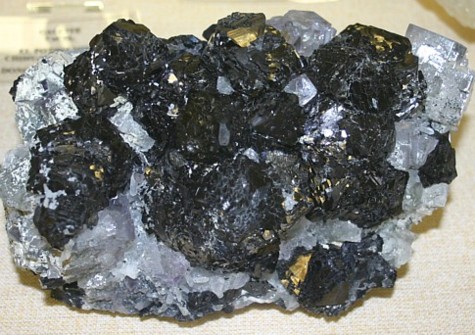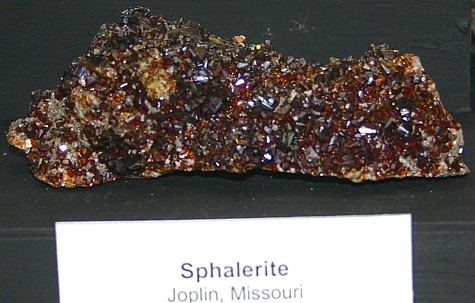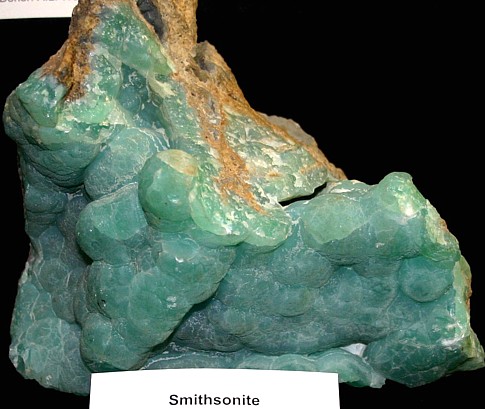Zinc is a bluish-white brittle metal, possessing a crystalline structure, and is reported to have been found native in Australia. It melts at 520 C., and has a specific gravity of about 7.15. At a temperature between 100 C and 150 C, it may be rolled out into sheets or drawn into wire, but at 300 C. it reverts to a brittle condition, and may be readily powdered under the hammer. It becomes superficially tarnished in moist air, and is soluble in dilute acids. Zinc is obtained by heating in retorts at a high temperature its roasted or calcined ores in admixture with coal or coke. The zinc oxide is reduced to metal, which, being volatile, distils, and is condensed. Smelting in electric furnaces has been experimented with, but considerable difficulties must yet be overcome before this method can be pronounced a success. Metallic zinc (spelter) is used chiefly for coating (galvanizing) iron, and in the manufacture of the various alloys with copper, known as brass. Zinc oxide and zinc sulphide are both used as pigments, and are sometimes specified in place of white lead; they are less poisonous and retain their color better than white lead, although their covering power is inferior. Metallic zinc is also used for electrical storage in dry batteries. Zinc dust or zinc shavings are used to precipitate gold and silver from its solution in the cyanide process. Zinc chloride is used as a wood preservative.
The chief sources of zinc are sphalerite and smithsonite. The former often exists in vast quantities associated with galena, which is an objectionable constituent from the point of view of the zinc smelter. The metallurgical treatment of this "refractory sulphide ore" has long been a problem, and although great improvements have been effected in mechanically separating the two values by wet dressing, oil flotation, etc., and various chemical and metallurgical processes have been devised, it does not yet appear to have been solved by the introduction of a process of universal application. Principally owing to the improved methods of mechanical separation, large deposits of zinc-lead sulphide ores are being opened up in Siberia, Burma, etc., in addition to those in Australia, the western US and elsewhere.
Historically, much of the world's production of zinc came from the United States, Germany, and Belgium. For many years, the chief zinc ore producing country was the United States. The percentage of zinc in the ore mined is frequently very low, and often averages 3 per cent., but this is increased by concentration. The Broken Hill district in New South Wales produces about 20 per cent, of the world's production in the form of concentrates, averaging from 40 to 45 per cent, metallic zinc. Zinc sulphide oxidizes to the soluble zinc sulphate, and zinc minerals are readily dissolved by sulphuric acid. Zinc is precipitated from sulphuric acid solutions by carbonates. In limestone rich zinc carbonate deposits are found near sulphide ores that are oxidizing. Smithsonite also is secondary. In depth zinc is precipitated as sulphides, both wurtzite and sphalerite being formed by secondary processes. Smithsonite is not amenable to wet concentration, and smelters do not readily purchase such ores containing less than 35 percent zinc. Fluorite is frequently associated with zinc ores, and is an objectionable constituent. The zinc minerals are Zincite, Franklinite, Sphalerite, Smithsonite, Willemite, Hemimorphite, and Goslarite. Zinc minerals heated on charcoal give an encrustration, which is yellow when hot, white when cold, and which, if moistened with cobalt nitrate and strongly reheated, assumes a fine green color.
The sulphide, sphalerite, is the one most common primary ore of zinc. The carbonate, smithsonite, and the silicate, smithsonite, are usually associated with sphalerite deposits as secondary minerals. The three minerals, zincite, franklinite and willemite, are found in unique deposits at Franklin Furnace, New Jersey. Together with a large number of rare and unusual minerals they form anticlinal beds lying intercalated in a limestone series. In general sphalerite, the chief ore of zinc, is found in irregular replacement deposits in limestone. It is very frequently intimately associated with lead minerals. In deep-seated veins which have not suffered oxidation, sphalerite is generally the ore mineral found. Not all primary zinc deposits are sulphides; a noteworthy exception is presented by those of Franklin Furnace, New Jersey in which zinc occurs as primary oxides, and silicate franklinite, zincite, and willemite. Franklinite, willemite, and zincite are of comparatively limited distribution and the only locality where these are of importance as ore minerals is. Franklin in New Jersey, U.S.A. Smithsonite, hemimorphite, and hydrozincite arise from the alteration of sphalerite in the oxidation zone. The name "calamine" is conveniently applied to the mixed oxidized ore consisting as a rule chiefly of impure smithsonite, though other oxidation products may be present.
Numerous minerals occur associated with sphalerite in veins of zinc ore, one of the commonest of these being galena. The more important of the other associated minerals are calcite, dolomite, siderite, pyrite, chalcopyrite, and barite. Sphalerite frequently contains small amounts of cadmium sulphide, and the cadmium of commerce is obtained from sphalerite and other zinc ores. Nearly all zinc sulphide ores carry some lead; the western ores of zinc generally carry silver, and some of them carry both silver and gold. Pyrite, pyrrhotite, chalcopyrite, and galena are very commonly associated with sphalerite in sulphide deposits. The most common gangue minerals are quartz, calcite, and dolomite. Rhodochrosite and rhodonite are abundant in zinc ores at Butte, Montana. In some deposits the heavy silicates, such as garnet and actinolite, are intergrown with sulphides of zinc and lead. Goslarite occurs on the walls of some mine workings as a white efflorescence. Owing to the high solubility of zinc sulphate in water, goslarite is comparatively rare in most districts.
Smithsonite is commonly found in the oxidized zones of zinc bearing veins. It is most abundant in deposits in limestone. It has not been reported as a primary mineral in deposits formed by hot ascending waters. Where zinc sulphate waters attack limestone, smithsonite is deposited, calcium sulphate going into solution. Smithsonite is commonly associated with smithsonite in the oxidized zones of zinciferous ores. It is not known as a primary mineral of ore veins deposited from hot solutions. Willemite, the anhydrous silicate, is much less common than smithsonite. It is abundant in the primary ores of Franklin Furnace, N. J., but is not reported as occurring in the secondary ores at many zinc deposits. Hydrozincite the basic carbonate, occurs commonly in altered ores. Aurichalcite, a basic carbonate of zinc and copper, is deposited by cold solutions, generally as drusy incrustations. Wurtzite, as shown by Butler, is secondary in the San Francisco district, Utah. It is probably secondary at Butte, Montana.
Genesis of Zinc Deposits. Zinc is rare in deposits formed by magmatic segregation but occurs in deposits formed at considerable depths and in contact-metamorphic deposits. In some deposits of the last-named class sphalerite is abundant. The great deposits of zinc in North America, which are associated with igneous intrusives, were formed for the most part at moderate depths. Zinc offers some puzzling problems in its concentration by enrichment. It dissolves very readily in sulphuric acid, and so as a rule outcrops of zinc-bearing ores are leached of zinc. In calcareous rocks the zinc which is leached out of sulphide ores is deposited as carbonate by replacement of the lime carbonate around the older deposit. Some zinc that is dissolved in sulphate solutions descends and is deposited as secondary sphalerite and wurtzite.
Secondary sphalerite has been found in western ore deposits in rocks other than limestone, but so far as the records show its occurrence in western deposits is rare. Large quantities of zinc are undoubtedly dissolved from the outcrops and oxidized zones of deposits in which it occurs as sulphide and are passed as sulphate downward, below the water level. Considerable amounts, however, may be carried in fissures and fractures that join the original deposit and be redeposited at some distance from the primary deposit. On account of the greater solubility of their salts in an alkaline and reducing environment, zinc and iron migrate more extensively and farther from the original sources than gold and silver. At Tintic, Utah, valuable bodies of oxidized zinc ore are found on the borders of older sulphide deposits. In this district and at Leadville Colo., and in the Cerro Gordo vein, California, oxidized iron-stained zinc carbonate ores, unnoticed for many years, have lately become prominent sources of zinc.
Return
to Metal Ores Page:
Precious and Base Metal Ores

Crystals of Sphalerite, the chief ore of Zinc.

Above: Another example of Sphalerite, which is zinc sulfide.

Above: Smithsonite, a minor ore of zinc. It is a zinc carbonate formed by weathering, so it is only found in the zone of surface oxidation.
